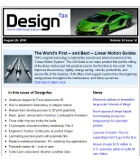 |
| April 08, 2025 | Volume 21 Issue 14 |
Electrical/Electronic News & Products
Designfax weekly eMagazine
Archives
Partners
Manufacturing Center
Product Spotlight
Modern Applications News
Metalworking Ideas For
Today's Job Shops
Tooling and Production
Strategies for large
metalworking plants
Board-level EMI shielding: DIY in minutes
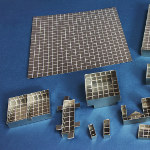 ProtoShield sheets from Tech-Etch are depth-etched with a checkerboard pattern for folding, so they can be easily formed into many diverse configurations. In the product-development stage, fully functional shields can be created in minutes with just a pair of scissors and a straight edge for folding. Offered in two sizes: standard (.25-in. squares) and metric (5-mm squares). Both versions are solderable and corrosion resistant due to nickel silver material. Shield prototypes can be directly soldered to the board, or shield clips can be used for easy mounting. Samples available.
ProtoShield sheets from Tech-Etch are depth-etched with a checkerboard pattern for folding, so they can be easily formed into many diverse configurations. In the product-development stage, fully functional shields can be created in minutes with just a pair of scissors and a straight edge for folding. Offered in two sizes: standard (.25-in. squares) and metric (5-mm squares). Both versions are solderable and corrosion resistant due to nickel silver material. Shield prototypes can be directly soldered to the board, or shield clips can be used for easy mounting. Samples available.
Learn more.
Isolated probing tech for fast-switching power device testing
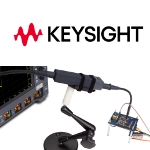 Keysight Technologies has developed an optically isolated differential probing family dedicated to enhancing efficiency and performance testing of fast-switching devices such as wide-bandgap GaN and SiC semiconductors. Validation of floating half-bridge and full-bridge architectures commonly used in power conversion, motor drives, and inverters requires measurement of small differential signals riding on high common-mode voltages. This measurement can be challenging due to voltage source fluctuations relative to ground, noise interference, and safety concerns.
Keysight Technologies has developed an optically isolated differential probing family dedicated to enhancing efficiency and performance testing of fast-switching devices such as wide-bandgap GaN and SiC semiconductors. Validation of floating half-bridge and full-bridge architectures commonly used in power conversion, motor drives, and inverters requires measurement of small differential signals riding on high common-mode voltages. This measurement can be challenging due to voltage source fluctuations relative to ground, noise interference, and safety concerns.
Learn more.
Protect sensitive electronics in explosive environments with new aluminum ATEX Cabinet Cooler Systems
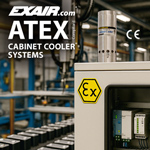 EXAIR's ATEX Cabinet Cooler® Systems deliver a powerful and affordable solution for keeping electrical enclosures cool in hazardous ATEX classified areas -- and they're now available in durable aluminum construction. Engineered for use in Zones 2 and 22, these coolers are UL tested, CE compliant, and meet stringent ATEX standards for purged and pressurized enclosures. With cooling capacities up to 5,600 Btu/Hr., ATEX Cabinet Coolers are ideal for preventing overheating in electrical cabinets. EXAIR offers a comprehensive lineup of systems.
EXAIR's ATEX Cabinet Cooler® Systems deliver a powerful and affordable solution for keeping electrical enclosures cool in hazardous ATEX classified areas -- and they're now available in durable aluminum construction. Engineered for use in Zones 2 and 22, these coolers are UL tested, CE compliant, and meet stringent ATEX standards for purged and pressurized enclosures. With cooling capacities up to 5,600 Btu/Hr., ATEX Cabinet Coolers are ideal for preventing overheating in electrical cabinets. EXAIR offers a comprehensive lineup of systems.
Learn more.
PLC handbook chock full of must-know information
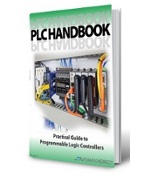 Automation-Direct's Practical Guide to Program-mable Logic Controllers Handbook has been improved with tons of new need-to-know info, making it a more comprehensive guide to the world of PLCs. Besides covering the basics of PLC history, PLC hardware, and PLC software, this guide takes you deeper into the ever-changing world of PLC communication, the importance of feedback loops, cyber security, and many other areas that are a must-know for any PLC novice or seasoned automation professional.
Automation-Direct's Practical Guide to Program-mable Logic Controllers Handbook has been improved with tons of new need-to-know info, making it a more comprehensive guide to the world of PLCs. Besides covering the basics of PLC history, PLC hardware, and PLC software, this guide takes you deeper into the ever-changing world of PLC communication, the importance of feedback loops, cyber security, and many other areas that are a must-know for any PLC novice or seasoned automation professional.
Get this great resource today.
Haptic feedback prototyping kit from TDK
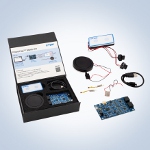 Get your customers to feel the difference your products make. TDK has released a development starter kit for fast haptics prototyping. It gives mechanical designers and engineers first impressions of the haptic feedback using PowerHap piezo actuators, shows how the mechanical integration works, and provides a reference design. Applications include automotive, displays and tablets, household appliances, vending machines, game controllers, industrial equipment, and medical devices.
Get your customers to feel the difference your products make. TDK has released a development starter kit for fast haptics prototyping. It gives mechanical designers and engineers first impressions of the haptic feedback using PowerHap piezo actuators, shows how the mechanical integration works, and provides a reference design. Applications include automotive, displays and tablets, household appliances, vending machines, game controllers, industrial equipment, and medical devices.
Learn more.
Mini ESD preset torque screwdriver
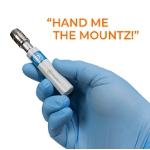 Need precision fastening with ESD protection at the smallest torque levels? Mountz has you covered. The new FG Mini ESD Preset Torque Screwdriver is built for low-torque, high-precision tasks. Its compact design makes it ideal for tight spaces and small fasteners, while delivering the same reliable control and ESD protection users have come to expect from Mountz. Two models available: FG25z (3 to 25 ozf.in, 2 to 17.7 cN-m) and FG50z (20 to 50 ozf.in, 14.1 to 35.3 cN-m).
Need precision fastening with ESD protection at the smallest torque levels? Mountz has you covered. The new FG Mini ESD Preset Torque Screwdriver is built for low-torque, high-precision tasks. Its compact design makes it ideal for tight spaces and small fasteners, while delivering the same reliable control and ESD protection users have come to expect from Mountz. Two models available: FG25z (3 to 25 ozf.in, 2 to 17.7 cN-m) and FG50z (20 to 50 ozf.in, 14.1 to 35.3 cN-m).
Learn more.
Laumas load cells and electronics from AutomationDirect
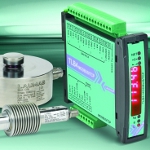 Automation-Direct has added Laumas precision-engineered load cells, transmitters, and accessories that deliver reliable performance in industrial weighing and force measurement applications. The FCAL series high-precision bending beam load cells are ideal for low- to mid-capacity systems. CTL series load cells are designed for both tension and compression, with excellent linearity. The CBL series low-profile compression load cells are perfect for space-limited applications. Laumas load cell transmitters are available too for precise monitoring and control. Very good pricing.
Automation-Direct has added Laumas precision-engineered load cells, transmitters, and accessories that deliver reliable performance in industrial weighing and force measurement applications. The FCAL series high-precision bending beam load cells are ideal for low- to mid-capacity systems. CTL series load cells are designed for both tension and compression, with excellent linearity. The CBL series low-profile compression load cells are perfect for space-limited applications. Laumas load cell transmitters are available too for precise monitoring and control. Very good pricing.
Learn more.
Engineer's Toolbox: What is ground loop feedback?
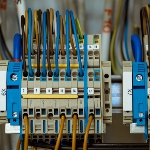 Improper grounding can create problems in data logging, data acquisition, and measurement and control systems. One of the most common problems is known as ground loop feedback. Experts at CAS DataLoggers run through five ways to eliminate this problem.
Improper grounding can create problems in data logging, data acquisition, and measurement and control systems. One of the most common problems is known as ground loop feedback. Experts at CAS DataLoggers run through five ways to eliminate this problem.
Read the full article.
What is a braking resistor?
 According to Automation-Direct, "Braking resistors don't actually provide braking directly -- rather, they allow a drive to stop a loaded motor faster." Why is this important? Protect your AC or DC drive system from regenerative voltage that can create an over-voltage fault on the drive -- especially with high inertial loads or rapid deceleration.
According to Automation-Direct, "Braking resistors don't actually provide braking directly -- rather, they allow a drive to stop a loaded motor faster." Why is this important? Protect your AC or DC drive system from regenerative voltage that can create an over-voltage fault on the drive -- especially with high inertial loads or rapid deceleration.
View the video.
New Digital Static Meter: Precise measurement, easy use
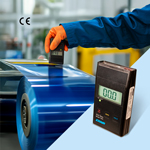 Static electricity isn't just a nuisance; it's a serious threat to manufacturing efficiency, product integrity, and workplace safety. Unchecked static can lead to costly downtime, product defects, material jams, and even hazardous shocks to employees. If static is interfering with your processes, EXAIR's upgraded Model 7905 Digital Static Meter offers an essential first step in identifying and eliminating the problem. With just the press of a button, this easy-to-use, handheld device pinpoints the highest voltage areas in your facility, helping you diagnose static issues before they become a problem.
Static electricity isn't just a nuisance; it's a serious threat to manufacturing efficiency, product integrity, and workplace safety. Unchecked static can lead to costly downtime, product defects, material jams, and even hazardous shocks to employees. If static is interfering with your processes, EXAIR's upgraded Model 7905 Digital Static Meter offers an essential first step in identifying and eliminating the problem. With just the press of a button, this easy-to-use, handheld device pinpoints the highest voltage areas in your facility, helping you diagnose static issues before they become a problem.
Learn more.
New laser cutting modulating strategy tested with Mikrotron high-speed camera
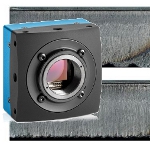 Modulating a laser beam's intensity distribution optimizes energy delivery to the process zone, resulting in better cutting speed, cut edge quality, and cut kerf geometry. Scientists in Belgium have come up with a new method that they say produces better cutting results.
Modulating a laser beam's intensity distribution optimizes energy delivery to the process zone, resulting in better cutting speed, cut edge quality, and cut kerf geometry. Scientists in Belgium have come up with a new method that they say produces better cutting results.
Read the full article.
All-in-one embedded PLC based on Raspberry Pi 4 -- build control applications
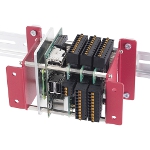 The new PLC CPI-PS10CM4 from Contec Co. is a compact embedded programmable logic controller (PLC) that is loaded with CODESYS, the world's most widely used software PLC. This product uses Contec's original single-board computer, which is based on Raspberry Pi's latest embedded module, the Compute Module 4 (CM4). By using the wide range of peripheral devices for Raspberry Pi, such as Contec's CPI Series, you can build various control applications in a PLC language that complies with the IEC 61131-3 international standard.
The new PLC CPI-PS10CM4 from Contec Co. is a compact embedded programmable logic controller (PLC) that is loaded with CODESYS, the world's most widely used software PLC. This product uses Contec's original single-board computer, which is based on Raspberry Pi's latest embedded module, the Compute Module 4 (CM4). By using the wide range of peripheral devices for Raspberry Pi, such as Contec's CPI Series, you can build various control applications in a PLC language that complies with the IEC 61131-3 international standard.
Learn more.
Torque sensors for fastening applications and more
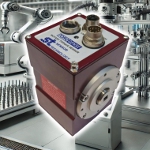 Saelig Company has introduced the Sensor Technology SGR525/526 Series Torque Sensors to provide precision torque monitoring that is critical for performance and safety. The square drive design (for applications with non-cylindrical shafts) allows for seamless integration into power tools, test rigs, industrial machinery, and precision fastening applications, ensuring superior torque measurement without the need for additional adapters or modifications. The SGR525 offers torque measurement only, while the SGR526 provides torque, speed, and power measurement using a 360-pulse-per-revolution encoder. Industries include automotive, aerospace, manufacturing, and research and development.
Saelig Company has introduced the Sensor Technology SGR525/526 Series Torque Sensors to provide precision torque monitoring that is critical for performance and safety. The square drive design (for applications with non-cylindrical shafts) allows for seamless integration into power tools, test rigs, industrial machinery, and precision fastening applications, ensuring superior torque measurement without the need for additional adapters or modifications. The SGR525 offers torque measurement only, while the SGR526 provides torque, speed, and power measurement using a 360-pulse-per-revolution encoder. Industries include automotive, aerospace, manufacturing, and research and development.
Learn more.
Wide-angle camera optimized for larger, faster conveyor belts
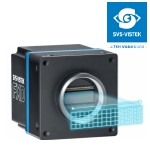 Wider conveyor belts operating at higher speeds are now commonplace in modern logistics. To keep up, SVS-Vistek is offering a cost-effective alternative to multi-camera systems with its fxo901CXGE 10-GigE color camera featuring the Sony IMX901-AQR wide-aspect global shutter 16.4-megapixel CMOS sensor. Unlike standard cameras, this unit captures targets in a wide field of view while maintaining high resolutions. The 4:1 horizontal aspect ratio allows one fxo901CXGE to replace an entire multi-camera system, removing the need for image synchronization.
Wider conveyor belts operating at higher speeds are now commonplace in modern logistics. To keep up, SVS-Vistek is offering a cost-effective alternative to multi-camera systems with its fxo901CXGE 10-GigE color camera featuring the Sony IMX901-AQR wide-aspect global shutter 16.4-megapixel CMOS sensor. Unlike standard cameras, this unit captures targets in a wide field of view while maintaining high resolutions. The 4:1 horizontal aspect ratio allows one fxo901CXGE to replace an entire multi-camera system, removing the need for image synchronization.
Learn more.
Handheld thermal imager cuts diagnostic time
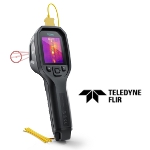 The FLIR TG268 is a next-generation thermal imager that provides professionals in the utility, manufacturing, electrical, automotive, and industrial sectors with a lightweight, handheld, affordable condition monitoring tool. Latest enhancements include higher temperature ranges, improved resolution, and larger data storage capacity. Go beyond the restrictions of single-spot IR thermometers to view and evaluate hot and cold spots that may signify potentially dangerous issues. Accurately measure temps from -25 to 400 C. Native thermal images improved with Super Resolution upscaling.
The FLIR TG268 is a next-generation thermal imager that provides professionals in the utility, manufacturing, electrical, automotive, and industrial sectors with a lightweight, handheld, affordable condition monitoring tool. Latest enhancements include higher temperature ranges, improved resolution, and larger data storage capacity. Go beyond the restrictions of single-spot IR thermometers to view and evaluate hot and cold spots that may signify potentially dangerous issues. Accurately measure temps from -25 to 400 C. Native thermal images improved with Super Resolution upscaling.
Learn more.
How to charge electric vehicles 5x faster in subfreezing temps: U-M researchers figure it out
A stabilizing coating on an electrode, combined with microscale channels, helps solve the tradeoff between range and charging speed, even in cold temperatures.
A modified manufacturing process for electric vehicle batteries, developed by University of Michigan (U-M) engineers, could enable high ranges and fast charging in cold weather, solving problems that are turning potential EV buyers away.
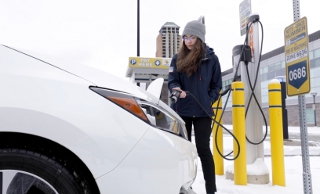
Engineering student Chloe Acosta plugs in an EV for charging in snowy weather on the University of Michigan's North Campus. EV charging becomes less efficient in colder weather, but a new strategy for manufacturing battery electrodes could enable charging in 10 minutes in temperatures as cold as -10 C. [Credit: Photo by Marcin Szczepanski, Michigan Engineering]
"We envision this approach as something that EV battery manufacturers could adopt without major changes to existing factories," said Neil Dasgupta, U-M associate professor of mechanical engineering and materials science and engineering, and corresponding author of the study published in Joule.
"For the first time, we've shown a pathway to simultaneously achieve extreme fast charging at low temperatures, without sacrificing the energy density of the lithium-ion battery."
Lithium-ion EV batteries made this way can charge 500% faster at temperatures as low as 14 F (-10 C). The structure and coating demonstrated by the team prevented the formation of performance-hindering lithium plating on the battery's electrodes. As a result, batteries with these modifications keep 97% of their capacity, even after being fast charged 100 times at very cold temperatures.
Current EV batteries store and release power through the movement of lithium ions back and forth between electrodes via a liquid electrolyte. In cold temperatures, this movement of the ions slows, reducing both battery power as well as the charging rate.
To extend range, automakers have increased the thickness of the electrodes they use in battery cells. While that has allowed them to promise longer drives between charges, it makes some of the lithium hard to access, resulting in slower charging and less power for a given battery weight.
Previously, Dasgupta's team improved battery charging capability by creating pathways -- roughly 40 microns in size -- in the anode, the electrode that receives lithium ions during charging. Drilling through the graphite by blasting it with lasers enabled the lithium ions to find places to lodge faster, even deep within the electrode, ensuring more uniform charging.
This sped up room-temperature charging significantly, but cold charging was still inefficient. The team identified the problem: the chemical layer that forms on the surface of the electrode from reacting with the electrolyte. Dasgupta compared this behavior to butter: You can get a knife through it whether it's warm or cold, but it's a lot harder when it's cold. If you try to fast charge through that layer, lithium metal will build up on the anode like a traffic jam.
"That plating prevents the entire electrode from being charged, once again reducing the battery's energy capacity," said Manoj Jangid, U-M senior research fellow in mechanical engineering, and co-author of the study.
The team needed to prevent that surface layer from forming. They did this by coating the battery with a glassy material made of lithium borate-carbonate, approximately 20 nanometers thick. The addition of this coating sped up cold charging significantly, and when combined with the channels, the team's test cells were 500% faster to charge in subfreezing temperatures.
"By the synergy between the 3D architectures and artificial interface, this work can simultaneously address the trilemma of fast charging at low temperature for long-range driving," said Tae Cho, a recent Ph.D. graduate in mechanical engineering and first author of the study.
In the past two decades, EVs have become more commonplace on roadways, but AAA survey results showed that the momentum is hard to maintain. From 2023 to 2024, the number of U.S. adults who would be "likely" or "very likely" to buy a new or used EV dropped from 23% to 18%, and 63% said they would be "unlikely" or "very unlikely" to make an EV their next vehicle purchase. Part of the concerns are range drops over the winter, combined with slower charging, which was widely reported during the January 2024 cold snap.
"Charging an EV battery takes 30 to 40 minutes, even for aggressive fast charging, and that time increases to over an hour in the winter. This is the pain point we want to address," Dasgupta said.
Source: University of Michigan
Published April 2025
Rate this article
View our terms of use and privacy policy
